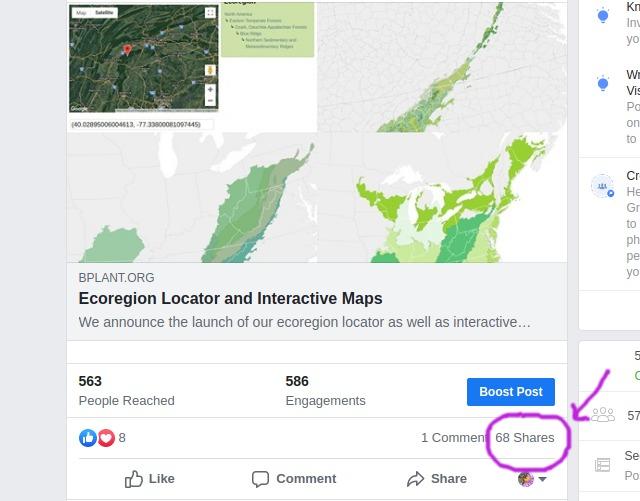We Are Now Accepting Donations
October 14th, 2019 by Alex Zorach

I have worked on bplant.org for over a year as a side project with no compensation, while using other sources of income to sustain my work. I would like to raise funding for bplant.org. Funding could help the project progress faster by allowing me to dedicate more time to it, and by hiring others if we receive enough funding.
I am publishing an FAQ (Frequently Asked Questions) to address some of the questions people have raised when I've talked about donations. You can find this FAQ in the site footer, under Support Us » FAQ. I will keep the permanent FAQ up-to-date as anything changes.
Donation and Funding FAQ
Why is this project important? What does it offer beyond existing websites?
Discussion of plant blindness, the decline of insect populations, and increased knowledge of the importance of native plants have led to a surge of interest in plant identification, tracking the native vs. introduced ranges of plants, and the ecological relationships among plants and between plants and other organizations.bplant.org aims to address these issues beyond existing websites in two primary ways: a greater focus on ecology and a new technology and development model.
The focus on ecology includes discussion of habitat, life-cycle, and faunal associations of specific plants. This focus on ecology also involves highlighting ecoregions rather than political boundaries. It also involves new ways of tracking and distinguishing wild vs. cultivated plants, as well as native vs. introduced plants.
Technologically, we use a rapid, sustainable development model. Responsive design creates a unified experience between desktop computers and mobile devices, allowing mobile users full access to all site features without downloading an app. Our lean approach to web design creates pages that load quickly and place lighter burdens on processors, thus reducing carbon emissions associated with electricity usage. Our site has experienced almost no downtime, with only a few minutes total downtime so far in 2019, contrasting with the USDA PLANTS database and BONAP, both of which that have experienced hours or days in which their site was totally inaccessible during this period.
Our technological approach has allowed us to achieve a lot in a short period of time, and will continue to do so.
How can I donate money?
We currently accept donations through Liberapay, which accepts payments through Credit Cards or Paypal. You can donate here, and you can also find the donation link in the site footer. We chose to use Liberapay because it allows you to make recurring donations, because it is free open-source software, and because it charges no additional fees beyond payment processing. For large donations, if you are interested in a greater portion of the proceeds reaching us (Paypal or Stripe, credit card processors, take around 3% of a typical transaction) please contact us about donating by personal check.If you are interested in donating money but neither of these options work for you, please get in touch and we can work something out.
How can I support bplant.org if I can't or don't want to donate?
If you want to support us financially but either lack the means to do so, or just don't want to, you can ask others to donate on your behalf, as a gift. You can also share this post or our donation link with others who may be more likely to donate. Our post about the ecoregion locator had a total of 68 shares and reached over 500 people through Facebook alone; re-sharing our posts helps us in multiple ways.
Our post about the ecoregion locator had a total of 68 shares and reached over 500 people through Facebook alone; re-sharing our posts helps us in multiple ways.You can also help us a lot by sharing or linking to our site in general. Not only does sharing indirectly help us raise funds, but, more importantly, it helps our educational resources reach a broader audience, furthering our mission. Greater visits to our site also help us get better data on what information there is demand for, which helps us to better prioritize our work.
Why would I donate to a business or individual that is not a non-profit organization?
An organization being a 501(c)(3) organization in the United States, or any other type of legally-recognized non-profit organization, is a formality that affords certain tax advantages to organizations that are structured and run in a specified way. An organization's non-profit status is not a guarantee that the organization conducts itself in a way most people would deem charitable. For example, some charities pay their CEO's salaries over $1 million annually (source), and if you look specifically at hospitals and large health clinics, there are many people paid over $5 million in salaries and an overwhelming majority of such organizations paying their top executives over $1 million (source).For an overwhelming majority of people, there is no tax benefit to donating to a non-profit. Charitable tax deductions in the U.S. are only available to those who itemize deductions. The 2017 Tax Reforms in the U.S. hugely reduced the portion of people who benefit from itemizing deductions. Even if you do personally itemize deductions, you can still achieve more good in the world by giving to a non-tax-deductible cause if that cause is achieving more with your money.
I am committed to running bplant.org with financial transparency that goes above and beyond how typical non-profit organizations are run, publishing our income and expenses in easy-to-understand documents on our website.
How and where will you use the money?
We have negligible costs currently, because of piggybacking on the other websites managed by Merit Exchange LLC, which include RateTea, a site currently with much more traffic than bplant.org, and several other websites. However, as bplant.org scales up to have more traffic, we may need to pay a small amount for cloud hosting and other technology services including email.Initially, most of the income will be used to pay me (Alex Zorach). This will allow me to dedicate more time to working on the site. If we reach a sufficient threshold, we will hire others. I am committed to never paying any individual more than about $88K annually (in 2019 dollars, adjusted for inflation) and would hire another person well before paying myself a salary this high. This figure is based on inflation-adjusting a 2010 study that found that increases in personal incomes over $75,000 do not affect happiness. A 2018 Study found similar results.
We may also donate money to organizations whose work, resources, or data we use, to nature preserves or land conservation organizations, and other organizations that closely align with our mission, especially when the work is directly related to material on our site.
What are some results that could be facilitated by more funding?
With more funding the following projects could advance more quickly:- Refining plant range maps, and completing range maps for non-native/introduced species, as described in this blog post.
- Completing articles on all ecoregions of the continental U.S., and more broadly, North America, including Mexico and Canada.
- Completing and expanding more plant articles
- Adding more photos, both of plants and ecoregions
- Developing plant ID guides
How can we trust that you will use the money to make a difference in the world?
One of the best indicators of how an organization will use money is the work it is already doing. Since our launch in 2019, we have published hundreds of articles, ecoregion maps of North America, and tentative range maps of most plants native to North America. We also have developed and tested many of the interactive features of the site for tracking and reporting plant observations.And we've done all of this with zero funding whatsoever.
Many organizations have achieved a lot less than the work we've already done, with significant budgets and personnel. You've seen what we can do, and you can expect more of the same! Funding will primarily ensure that we can continue doing what we already have been doing, and that we can do more of it, as well as continually improving the quality of the resources we have already created.
Are you seeking any income or monetizing the site in other ways?
For bplant.org, not currently. The other sites run by Merit Exchange LLC generate income through advertising and affiliate links. I would rather keep advertisement or affiliate links either off bplant.org entirely, or to a minimum. However, I have considered seeking income through these methods. The best way to ensure bplant.org remains fully advertising-free is to donate money so that there is no need to resort to these other income sources. Without any donations, I will probably eventually add at least some minimal advertising in order to cover server costs and provide some minimal compensation as the site grows. I have also considered an institutional subscription model as some educational institutions subscribe to various databases and open journals.Since I am actively soliciting funding, if I do earn any income associated with bplant.org through advertising, affiliate links, or other sources, I will publish the gross earnings from these other sources as well.
Any more questions?
Please get in touch! I am eager to answer any further questions from anyone considering donating!Archive of All Blogs
The Bias Against Tall Plants, November 11th, 2025
A Focus on Goldenrods (Solidago sp.), July 23rd, 2025
Disturbance and its Role in Plant Habitat Preferences, May 29th, 2025
What "Native" or "Introduced" Mean: Myths and Misconceptions, March 11th, 2025
Smarter & More Informative Search Results, January 13th, 2025
The Effect of the 2024 US Election on Plant Biodiversity and bplant.org, October 30th, 2024
The Problems With Nursery-Bought Plants, And The Solutions, October 8th, 2024
More Databases Linked & Search Improvements for Scientific Names, July 9th, 2024
Choosing The Best Common Names For Plants: Challenges & Solutions, April 19th, 2024
Range Map & Taxonomic Update Progress, January 31st, 2024
Giving Thanks To Everyone We Rely On, November 22nd, 2023
Thinking More Deeply About Habitat, April 5th, 2023
2022 Year-End Summary: Successes & New Goals, February 15th, 2023
New Databases Linked: Flora of North America & NatureServe Explorer, November 11th, 2022
All Range Maps 2nd Generation, Taxonomic Updates, & Fundraising Goal Met!, September 29th, 2022
More Range Map Improvements, POWO Interlinking, And Notes Fields, June 7th, 2022
Ecoregion-Based Plant Lists and Search, March 30th, 2022
Progress Updates on Range Maps and More, February 10th, 2022
The Vision for bplant.org, December 9th, 2021
New Server: Software & Hardware, August 30th, 2021
More & Improved Plant Range Maps, July 19th, 2021
A Control Section for Invasive Plants, April 15th, 2021
Progress Bars & State Ecoregion Legends, March 11th, 2021
Our 2020 Achievements, February 9th, 2021
Interlinking Databases for Plant Research, November 11th, 2020
A New Homepage, Highlighting Our Articles, July 29th, 2020
A False Recovery, But North Carolina's Ecoregions are Complete!, June 9th, 2020
We're Back After COVID-19 Setbacks, April 3rd, 2020
Help Us Find Ecoregion Photos, February 27th, 2020
What We Achieved in 2019, December 30th, 2019
Plant Comparison and ID Guides, October 30th, 2019
We Are Now Accepting Donations, October 14th, 2019
US State Ecoregion Maps, New Footer, Ecoregion Article Progress, and References, September 19th, 2019
Tentative Range Maps of Native Plants, August 12th, 2019
Ecoregion Locator and Interactive Maps, July 10th, 2019
Using Ecoregions Over Political Boundaries, May 13th, 2019
How We Handle Wild vs Cultivated Plants, April 16th, 2019
A Blog To Keep People Updated On Our Progress, April 8th, 2019
Sign Up
Want to get notified of our progress? Sign up for the bplant.org interest list!


